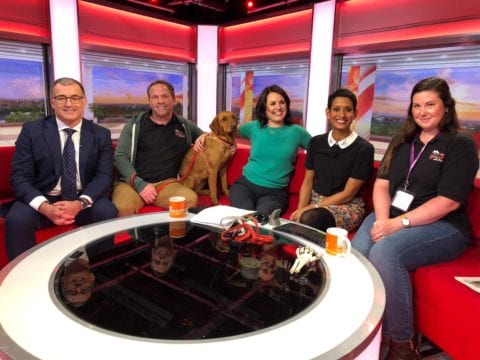Ryan White, Managing Director of We Love Pets speaks to BBC Breakfast about how to avoid wrist injury while walking your dog.
Did you know that the way you hold your dog’s lead could result in serious hand or wrist injury?
Research from the Royal Cornwall Hospital warns that thousands of people could be suffering from serious wrist injuries resulting from holding dog leads incorrectly.
“The problem arises when you wrap the lead around your hand, you can cause dislocation from the lead tightening and then the sudden surge of a dog pulling forwards.” Ryan White, Managing Director at We Love Pets
The types of injury sustained can range from a simple sprain which could get better in a few days right through to lifelong disability with stiffness and deformity.
The Hospital analysed hand injury cases over a year and identified 30 serious hand injuries caused by dog lead or collar misuse. Injuries included fractures, dislocation, skin loss in some cases which were all down to wrapping a dog lead around their fingers.
Mike Hayton, a hand surgeon and member of The British Society for Surgery of the Hand appeared on BBC Breakfast with dog behaviour and training expert Ryan White to talk about how these types of injuries can be avoided.
“You never have to hold the dog so tight, that is where the problem comes from. If the dog was to twist in excitement, you’ve got a dislocated finger.” – Ryan White
Avoid wrapping your fingers around the lead or hooking your finger under the collar. If the dog were to suddenly lurch forward you could get a nasty shock and serious injury.
To handle the dog with a lead use two hands; anchor at the handle of the lead and guide with your other hand further down the lead near the collar – but not under it. Watch Ryan demonstrate to BBC viewers how it’s done.
“The biggest problem is when you use the lead as the primary control. It needs to be the secondary control. Primary control is you talking to the dog and giving the dog commands and with correct training the lead itself won’t cause the issues.” – Ryan White
Ryan suggests that the lead should be the last port of call and that the bigger picture is learning how to control the dog through voice command.
It can be simple to control your dog with a loose lead. When you walk your dog it does something called checking in; this might be cocking its ear or looking at you. When a dog checks in is the optimum time for the dog to respond to your command. Leads and harnesses are a good training aid to start with to help the dog turn its head slightly to check in but ultimately the end goal is to not have a lead on at all.
If you would like to learn more about how to walk a dog correctly and become an expert yourself, enrol on one of our training courses or read our blog for general pet care tips and advice.




